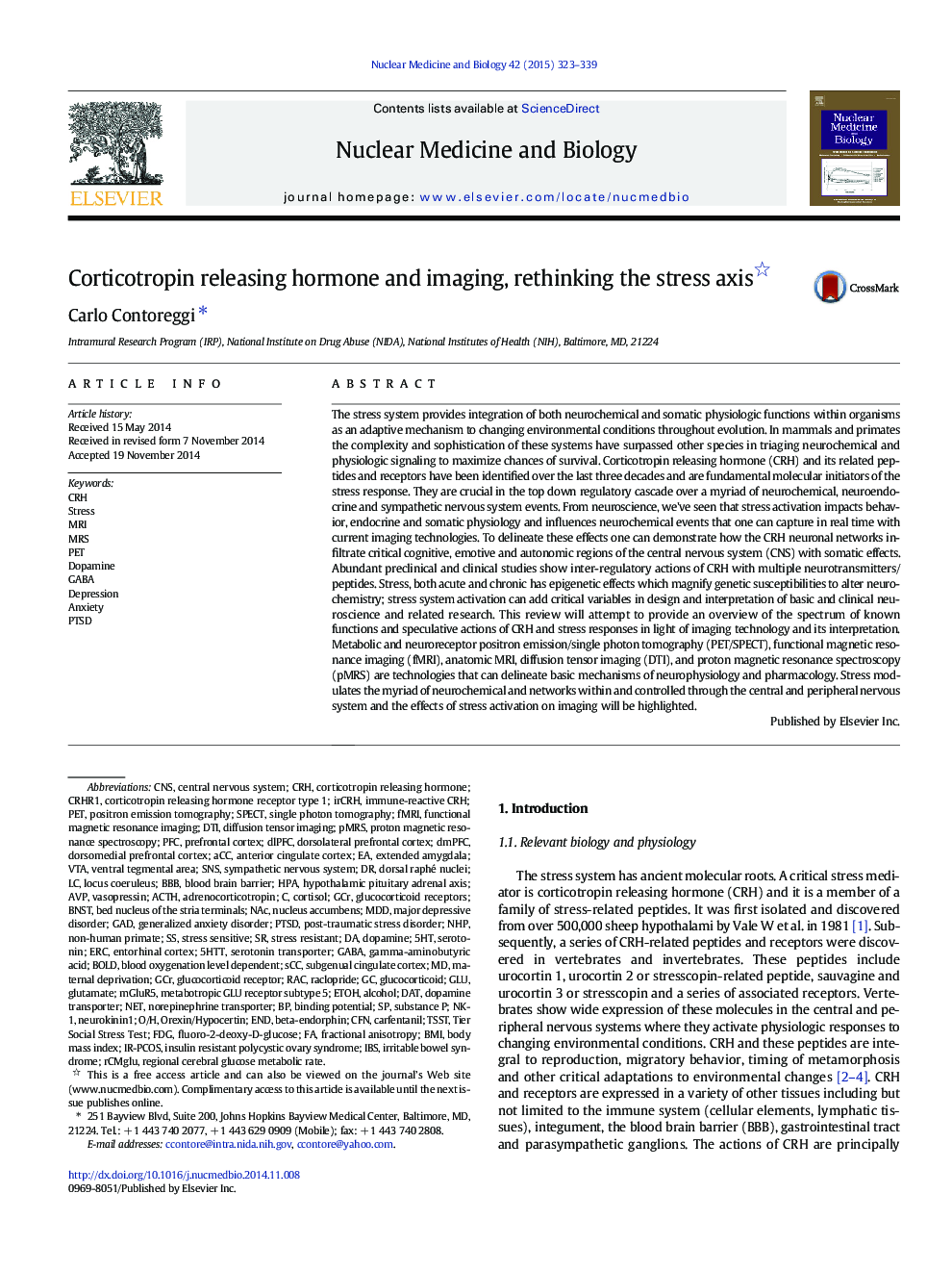| کد مقاله | کد نشریه | سال انتشار | مقاله انگلیسی | نسخه تمام متن |
|---|---|---|---|---|
| 2153456 | 1090188 | 2015 | 17 صفحه PDF | دانلود رایگان |
عنوان انگلیسی مقاله ISI
Corticotropin releasing hormone and imaging, rethinking the stress axis
ترجمه فارسی عنوان
هورمون آزاد کننده کورتیکوتروپین و تصویربرداری، بازخوانی محور تنش
دانلود مقاله + سفارش ترجمه
دانلود مقاله ISI انگلیسی
رایگان برای ایرانیان
کلمات کلیدی
FDGNHPRacloprideMRSGADMDDIBSNK-1DATBNSTnorepinephrine transporterBOLDDMPFCAVPVTADTIDLPFC5HTACCCrhr1RACPFC5HTTCRHSCCERCmGluR5EtOHNACcFNGCRTSSTSNSPMRSACTHadrenocorticotropin - آدرنوکورتیکوتروپینextended amygdala - آمیگدال گسترش یافتهpost-traumatic stress disorder - اختلال استرس پس از ضربهPTSD - اختلال استرسی پس از ضایعه روانیgeneralized anxiety disorder - اختلال اضطراب فراگیرMajor depressive disorder - اختلال افسردگی عمدهStress - استرس یا فشار روانیgamma-aminobutyric acid - اسید گاما آمینو بوتیریکAnxiety - اضطرابDepression - افسردگیAlcohol - الکلMRI - امآرآی یا تصویرسازی تشدید مغناطیسیDopamine transporter - انتقال دهنده دوپامینBeta-endorphin - بتا آندورفینSPECT - برشنگاری رایانهای تک فوتونی، مقطع نگاری رایانهای تک فوتونی، توموگرافی رایانهای تک فوتونی، اسپکتdiffusion tensor imaging - تصویربرداری تانسور انتشارfMRI - تصویرسازی تشدید مغناطیسی کارکردیfunctional magnetic resonance imaging - تصویرسازی تشدید مغناطیسی کارکردیPositron emission tomography - توموگرافی گسیل پوزیترونNET - خالصCNS - دستگاه عصبی مرکزیDopamine - دوپامینBBB - سد خونی مغزیblood brain barrier - سد خونی مغزیSerotonin - سروتونینserotonin transporter - سروتونین حمل کنندهblood oxygenation level dependent - سطح اکسیژن خون وابسته استirritable bowel syndrome - سندروم روده تحریک پذیر، کولیت عصبیsympathetic nervous system - سیستم عصبی سمپاتیکcentral nervous system - سیستم عصبی مرکزیbody mass index - شاخص توده بدنBMI - شاخص توده بدنیProton magnetic resonance spectroscopy - طیف سنجی رزونانس مغناطیسی پروتونprefrontal cortex - قشر prefrontalEntorhinal cortex - قشر انتورینالanterior cingulate cortex - قشر سینگولیت قدامی، کورتکس سینگولیت قدامیSubgenual cingulate cortex - قشر مفصلی سینگولاتdorsomedial prefrontal cortex - قشر پیش از افسردگی پس از زایمانdorsolateral prefrontal cortex - قشر پیشانی غدد درون رحمیlocus coeruleus - لوکوس سیرولئوسSubstance P - ماده PMaternal deprivation - محرومیت مادرhypothalamic pituitary adrenal axis - محور غده هیپوفیز غده هیپوتالاموسHPA - میلی بار یا هکتوپاسکالventral tegmental area - ناحیه تگمنتوم شکمیfractional anisotropy - ناپیوستگی کسریnon-human primate - نخستیسانان غیرانسانیNucleus accumbens - هسته accumbensDorsal raphe nuclei - هسته رافه خالصcorticotropin releasing hormone - هورمون آزاد کننده کورتیکوتروپینvasopressin - وازوپرسینend - پایانPET - پتbinding potential - پتانسیل اتصالCarfentanil - کارفنتانیلcortisol - کورتیزولGABA - گاباGlu - گلوglutamate - گلوتاماتGlucocorticoid - گلوکوکورتیکوئیدهاglucocorticoid receptors - گیرنده های گلوکوکورتیکوئیدglucocorticoid receptor - گیرنده گلوکوکورتیکوئید
موضوعات مرتبط
علوم زیستی و بیوفناوری
بیوشیمی، ژنتیک و زیست شناسی مولکولی
تحقیقات سرطان
چکیده انگلیسی
The stress system provides integration of both neurochemical and somatic physiologic functions within organisms as an adaptive mechanism to changing environmental conditions throughout evolution. In mammals and primates the complexity and sophistication of these systems have surpassed other species in triaging neurochemical and physiologic signaling to maximize chances of survival. Corticotropin releasing hormone (CRH) and its related peptides and receptors have been identified over the last three decades and are fundamental molecular initiators of the stress response. They are crucial in the top down regulatory cascade over a myriad of neurochemical, neuroendocrine and sympathetic nervous system events. From neuroscience, we've seen that stress activation impacts behavior, endocrine and somatic physiology and influences neurochemical events that one can capture in real time with current imaging technologies. To delineate these effects one can demonstrate how the CRH neuronal networks infiltrate critical cognitive, emotive and autonomic regions of the central nervous system (CNS) with somatic effects. Abundant preclinical and clinical studies show inter-regulatory actions of CRH with multiple neurotransmitters/peptides. Stress, both acute and chronic has epigenetic effects which magnify genetic susceptibilities to alter neurochemistry; stress system activation can add critical variables in design and interpretation of basic and clinical neuroscience and related research. This review will attempt to provide an overview of the spectrum of known functions and speculative actions of CRH and stress responses in light of imaging technology and its interpretation. Metabolic and neuroreceptor positron emission/single photon tomography (PET/SPECT), functional magnetic resonance imaging (fMRI), anatomic MRI, diffusion tensor imaging (DTI), and proton magnetic resonance spectroscopy (pMRS) are technologies that can delineate basic mechanisms of neurophysiology and pharmacology. Stress modulates the myriad of neurochemical and networks within and controlled through the central and peripheral nervous system and the effects of stress activation on imaging will be highlighted.
ناشر
Database: Elsevier - ScienceDirect (ساینس دایرکت)
Journal: Nuclear Medicine and Biology - Volume 42, Issue 4, April 2015, Pages 323-339
Journal: Nuclear Medicine and Biology - Volume 42, Issue 4, April 2015, Pages 323-339
نویسندگان
Carlo Contoreggi,
